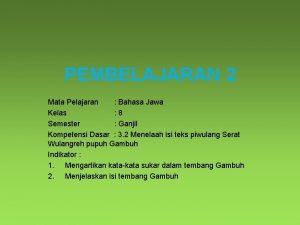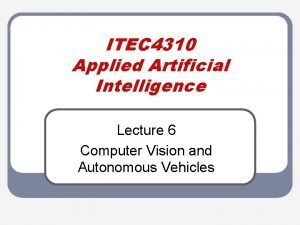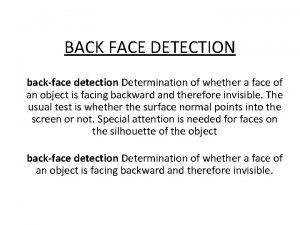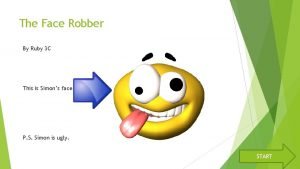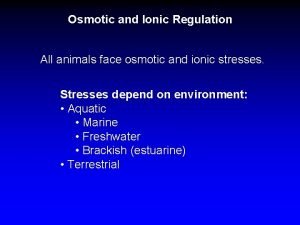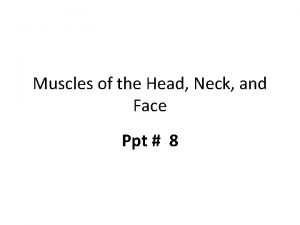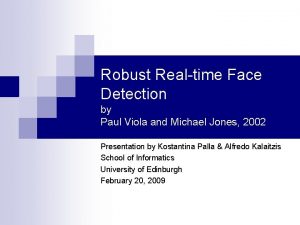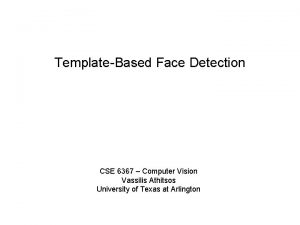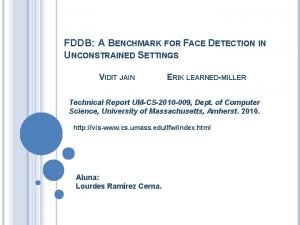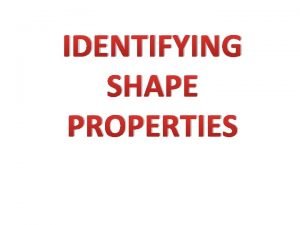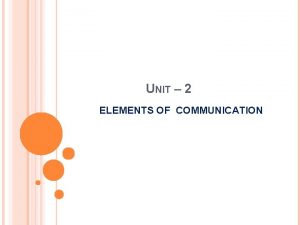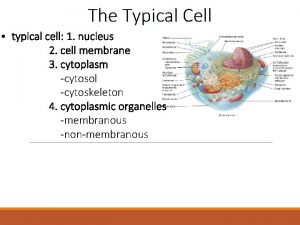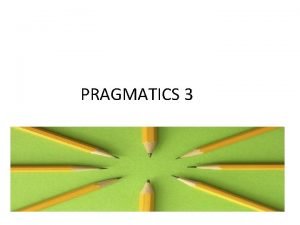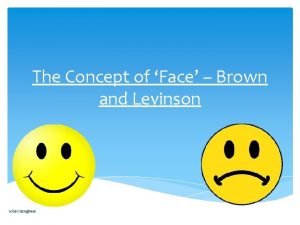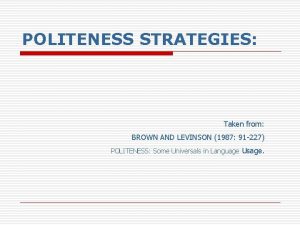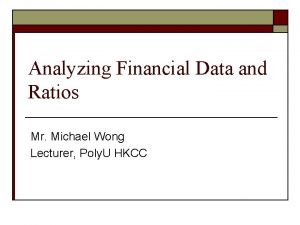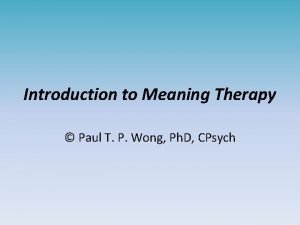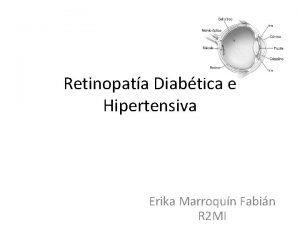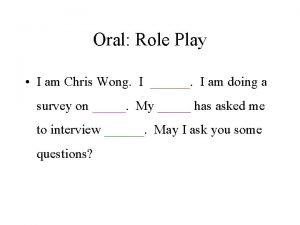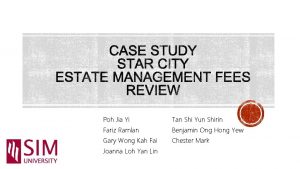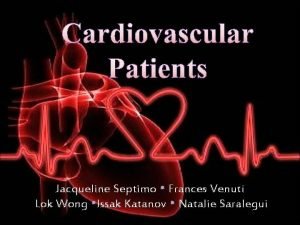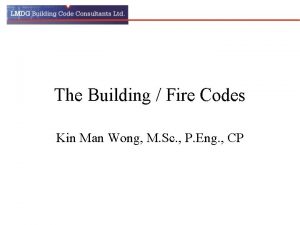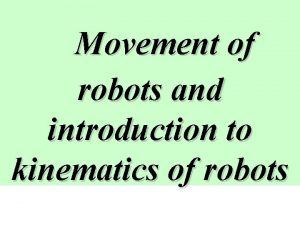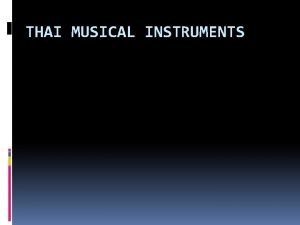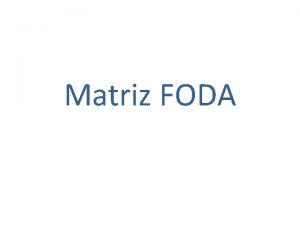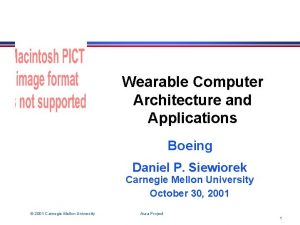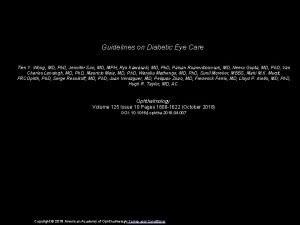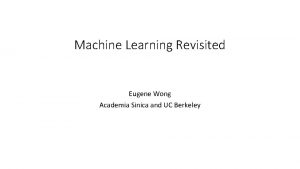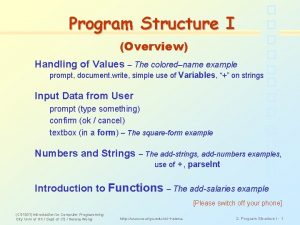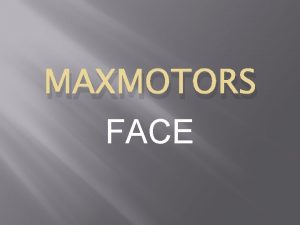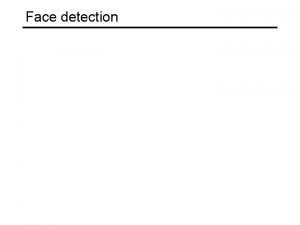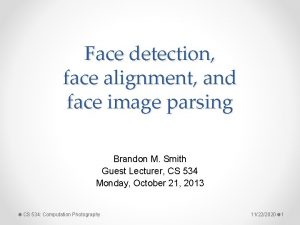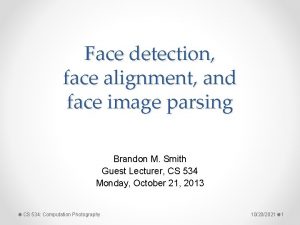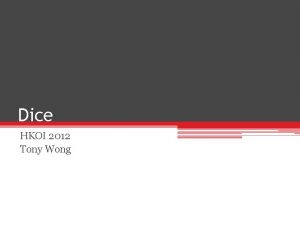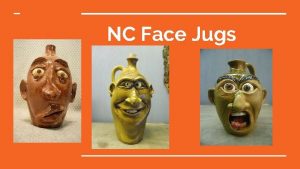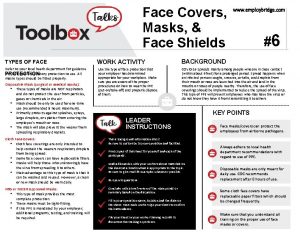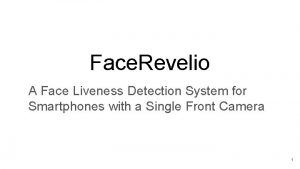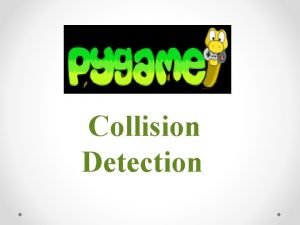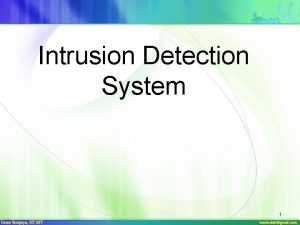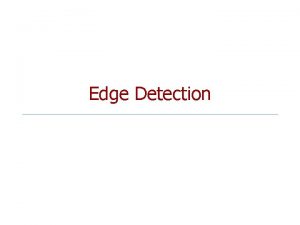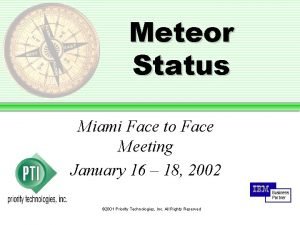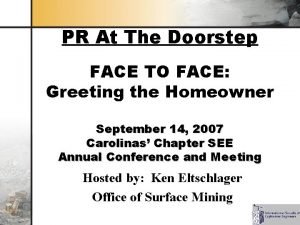Ch 7 Face detection KH Wong Face detection


![Face detection [1] • To detect faces in an image (Not recognize it yet) Face detection [1] • To detect faces in an image (Not recognize it yet)](https://slidetodoc.com/presentation_image/1c03f55845f7344d21eac3131aa720f3/image-3.jpg)


![The Viola and Jones method [1] • The most famous method • Training may The Viola and Jones method [1] • The most famous method • Training may](https://slidetodoc.com/presentation_image/1c03f55845f7344d21eac3131aa720f3/image-6.jpg)


![Image Features ref[3] A very simple feature calculation method “Rectangle filters” Rectangle_Feature_value f= ∑ Image Features ref[3] A very simple feature calculation method “Rectangle filters” Rectangle_Feature_value f= ∑](https://slidetodoc.com/presentation_image/1c03f55845f7344d21eac3131aa720f3/image-9.jpg)



![How to find features faster? Integral images fast calculation method [Lazebnik 09 ] • How to find features faster? Integral images fast calculation method [Lazebnik 09 ] •](https://slidetodoc.com/presentation_image/1c03f55845f7344d21eac3131aa720f3/image-13.jpg)

![Computing the integral image [Lazebnik 09 ] (x=1, y=1) Integral_img_ii(x, y-1) row_s(x-1, y) i(x, Computing the integral image [Lazebnik 09 ] (x=1, y=1) Integral_img_ii(x, y-1) row_s(x-1, y) i(x,](https://slidetodoc.com/presentation_image/1c03f55845f7344d21eac3131aa720f3/image-15.jpg)







![Class exercise 8. 4 Feature selection [Lazebnik 09 ] • For a 24 x Class exercise 8. 4 Feature selection [Lazebnik 09 ] • For a 24 x](https://slidetodoc.com/presentation_image/1c03f55845f7344d21eac3131aa720f3/image-23.jpg)







![Boosting for face detection [viola 2004] • In the paper it shows that the Boosting for face detection [viola 2004] • In the paper it shows that the](https://slidetodoc.com/presentation_image/1c03f55845f7344d21eac3131aa720f3/image-31.jpg)



![• An example More features for later stages in the cascade [viola 2004] • An example More features for later stages in the cascade [viola 2004]](https://slidetodoc.com/presentation_image/1c03f55845f7344d21eac3131aa720f3/image-35.jpg)

![Attentional cascade [Viola 2004] • Detection rate for each stage is 0. 99 , Attentional cascade [Viola 2004] • Detection rate for each stage is 0. 99 ,](https://slidetodoc.com/presentation_image/1c03f55845f7344d21eac3131aa720f3/image-37.jpg)
![Detection process in practice [smyth 2007] • Use 24 x 24 sub-window • Scaling Detection process in practice [smyth 2007] • Use 24 x 24 sub-window • Scaling](https://slidetodoc.com/presentation_image/1c03f55845f7344d21eac3131aa720f3/image-38.jpg)





![References 1. 2. 3. 4. 5. 6. 7. 8. [viola 2004] Paul A. Viola, References 1. 2. 3. 4. 5. 6. 7. 8. [viola 2004] Paul A. Viola,](https://slidetodoc.com/presentation_image/1c03f55845f7344d21eac3131aa720f3/image-44.jpg)


![Adaboost face detection Training algorithm [Jensen • 2008 ] 47 Face detection v. 0. Adaboost face detection Training algorithm [Jensen • 2008 ] 47 Face detection v. 0.](https://slidetodoc.com/presentation_image/1c03f55845f7344d21eac3131aa720f3/image-47.jpg)










![Answer: class exercise 8. 4 Feature selection [Lazebnik 09 ] • For a 24 Answer: class exercise 8. 4 Feature selection [Lazebnik 09 ] • For a 24](https://slidetodoc.com/presentation_image/1c03f55845f7344d21eac3131aa720f3/image-58.jpg)






- Slides: 64

Ch. 7: Face detection KH Wong Face detection v. 0. 1. a 1

Introduction • Face interface Face database – Face detection – Face recognition Output: Face detection Face recognition Mr. Chan Prof. . Cheng Face detection v. 0. 1. a 2
![Face detection 1 To detect faces in an image Not recognize it yet Face detection [1] • To detect faces in an image (Not recognize it yet)](https://slidetodoc.com/presentation_image/1c03f55845f7344d21eac3131aa720f3/image-3.jpg)
Face detection [1] • To detect faces in an image (Not recognize it yet) • Challenges – A picture has 0, 1 or many faces. – Faces are not the same: with spectacles, mustache etc. – Sizes of faces vary a lot. • Available in most digital cameras nowadays • The simple method – Slide a window across the window and detect faces. • Too slow, pictures have too many pixels. (1280 x 1024=1. 3 M pixels) Face detection v. 0. 1. a 3

Evaluation of face detection • Detection rate – Total number of faces that are correctly detected/total number of faces actually exist in the picture – Should be high > 95%. • False positive rate – The detector output is positive but it is false (there is actually no face). Definition of False positive: A result that is erroneously positive when a situation is normal. An example of a false positive: a particular test designed to detect cancer of the toenail is positive but the person does not have toenail cancer. (http: //www. medterms. com/script/main/art. asp? articlekey=3377) Should be low <10 -6 – • A good system has – High detection rate, – Low false positive rate. Face detection v. 0. 1. a False positive result 4

Example • What are the detection rate and false positive 6 faces correctly rate here? detected in the – Answer picture, 9 actually faces exist in the image • detection rate=(6/9)*100% • false positive rate=(1/7)*100% 7 windows reported to have faces , but in 1 window it is not a face Face detection v. 0. 1. a False positive result 5
![The Viola and Jones method 1 The most famous method Training may The Viola and Jones method [1] • The most famous method • Training may](https://slidetodoc.com/presentation_image/1c03f55845f7344d21eac3131aa720f3/image-6.jpg)
The Viola and Jones method [1] • The most famous method • Training may need weeks • Recognition is very fast, e. g. real-time for digital cameras. • Techniques 1. Integral image for feature extraction 2. Ada-Boost for face detection 3. Attentional cascade for fast rejection of non-face sub-windows Face detection v. 0. 1. a 6

Class exercise 8. 1 • Detected results are in red frames • What are the detection rate and false positive rate here? – Answer • detection rate=? • false positive rate=? Face detection v. 0. 1. a 7

The Viola and Jones method Technique 1: Integral image for feature extraction Face detection v. 0. 1. a 8
![Image Features ref3 A very simple feature calculation method Rectangle filters RectangleFeaturevalue f Image Features ref[3] A very simple feature calculation method “Rectangle filters” Rectangle_Feature_value f= ∑](https://slidetodoc.com/presentation_image/1c03f55845f7344d21eac3131aa720f3/image-9.jpg)
Image Features ref[3] A very simple feature calculation method “Rectangle filters” Rectangle_Feature_value f= ∑ (pixels values in white area) – ∑ (pixels values in shaded area) Face detection v. 0. 1. a 9

Example An image with gray levels shown 1 • Find the Rectangle_Feature_value (f) of the box enclosed by the 3 dotted line • • Rectangle_Feature_value f= ∑ (pixel value in white area) – ∑ (pixel value in shaded area) f=(8+7)-(0+1) =15 -1= 14 2 3 3 0 1 3 5 8 7 1 0 2 3 6 Face detection v. 0. 1. a 10

Class exercise 8. 2 • Find the 2 Rectangle_Feature_value (f) of the box enclosed by the 2 dotted line • • • Rectangle_Feature_value f= ∑ (pixel value in white area) – ∑ (pixel value in shaded area) f= 7 5 8 6 2 9 5 4 8 2 5 10 Face detection v. 0. 1. a 11

Example: A simple face detection method using one feature in the middle of image q. Rectangle_Feature_value f qf= ∑(pixels in white area) – ∑ (pixels in shaded area) q. If (f) is large, then it is face , i. e. qif (f)>threshold, then q face q. Else q non-face Result This is a face: The eye-area (shaded area)is dark, the nosearea(white area) is bright. So f is large, hence it is face This is not a face. Because f is small Face detection v. 0. 1. a 12
![How to find features faster Integral images fast calculation method Lazebnik 09 How to find features faster? Integral images fast calculation method [Lazebnik 09 ] •](https://slidetodoc.com/presentation_image/1c03f55845f7344d21eac3131aa720f3/image-13.jpg)
How to find features faster? Integral images fast calculation method [Lazebnik 09 ] • The integral image = sum of all pixel values above and to the left of (x, y) • Can be found very quickly by the hardware system Face detection v. 0. 1. a (x, y) 13

Examples Top-left corner(x, y)position=(1, 1) • The integral image = sum of all pixel values above and to the left of (x, y) • Pixel P is at (x=3, y=2) 1 2 3 3 3 4 6 3 – integral image of P is =1+2+3+3+4+6 x P 5 • integral image of Q is • =1+2+3+3+4+6+5+2+4+0 +2+3 0 2 4 1 2 3 Q 6 y Face detection v. 0. 1. a 14
![Computing the integral image Lazebnik 09 x1 y1 Integralimgiix y1 rowsx1 y ix Computing the integral image [Lazebnik 09 ] (x=1, y=1) Integral_img_ii(x, y-1) row_s(x-1, y) i(x,](https://slidetodoc.com/presentation_image/1c03f55845f7344d21eac3131aa720f3/image-15.jpg)
Computing the integral image [Lazebnik 09 ] (x=1, y=1) Integral_img_ii(x, y-1) row_s(x-1, y) i(x, y-1) i(x, y) • Cumulative row sum: row_s(x, y) = row_s(x– 1, y) + i(x, y) • • Integral image : Integral_img_ii(x, y) = Integral_img_ii(x, y− 1) + row_s(x, y) Face detection v. 0. 1. a 15

Calculate sum within a rectangle • A, B, C, D are the values of the integral images at the corners of the rectangle R. • The sum of image values inside R is: Area_R = A – B – C + D • If A, B, C, D are found , only 3 additions are needed to find Area_R • Calculations of areas can reused for other windows. Face detection v. 0. 1. a B D C For the Rectangle R the Area is Area_R A 16

Why do we need to find pixel sum of rectangles? Answer: We want to get face features • • You may consider these features as face features – Left Eye: (Area_A-Area_B) – Nose : (Area_C+Area_E-Area_D) – Mouth: (Area_F+Area_H-Area_G) • They can be different sizes, polarity and aspect ratios Face detection v. 0. 1. a A B C D E F G H 17

Face feature and example Shaded area -1 White area F=Feat_val = +2 Pixel values inside the areas 10 20 4 7 45 7 216 102 78 129 210 111 pixel sum in white area - pixel sum in shaded area Example • Pixel sum in white area= 216+102+78+129+210+111=846 • Pixel sum in shared area= 10+20+4+7+45+7=93 A face Feat_val=F=846 -93=753 If F>threshold, feature= +1 Else feature= -1 End if; If we can choose threshold =700 , so feature is Face detection v. 0. 1. a 18 +1.

Definition: Area_X = sum of pixels in the rectangular area from the lefttop corner to pixel X (including the top left corner and pixel X). Top-left corner • • • Find the feature output of this image. Area_D=1 Area_B=1+2+3=6 Area_C =1+3=4 Area_A=1+2+3+3+4+6=19 Area_E=? 1+3+5=9 Area_F=? 1+2+3+3+4+6+5+2+4=30 Pixel sum of the area inside the box enclosed by the dotted lines= Area_F - Area_B - Area_E +Area_D =? 30 -6 -9+1=16 1 2 3 D 3 B 4 6 2 4 Face detection v. 0. 1. a 1 F E 0 3 A C 5 3 2 3 6 19

Class exercise 8. 3 Definition: Area at X =pixel sum of the area from top-left corner to X= Area_X Top-left corner • • • Find the feature output of this image. Area_D=1 Area_B=1+2+3=6 Area_C =1+3=4 Area_A=1+2+3+3+4+6=19 Area_E=? 1+3+5=9 Area_F=? 1+2+3+3+4+6+5+2+4=30 Pixel sum of the area inside the box enclosed by the dotted lines= Area_F - Area_B - Area_E +Area_D =306 -9+1=16 WA=White area enclosed by the dotted line=? GA=Gray area enclosed by the dotted line=? (white area-shaded area)=WA-WG=? 1 2 3 D 3 B 4 6 2 4 Face detection v. 0. 1. a 1 F E 0 3 A C 5 3 2 3 6 20

Basic types of Rectangular Features for (white_area)-(gray_area) • Type) Rows x columns • Type 1) 1 x 2 • Type 2) 2 x 1 • Type 3) 1 x 3 • Type 4) 3 x 1 • Each basic type can have difference sizes and aspect ratios. • I. e. the following feature windows are of the same type (Type 2) even they have different sizes, or aspect ratios • Each rectangle inside is of the same dimension • Type 5) 2 x 2 Face detection v. 0. 1. a 21

Faces can be any sizes, Example: a face can be big or small , from 24 x 24 to 1024 x 1024, • There are faces with different sizes So, we need feature windows with different sizes. • • As long as white/gray areas have the relations The followings are Type 2 Rectangular Features – – The white rectangle is above the shaded rectangle White and shaded rectangle are of same dimension 22 Face detection v. 0. 1. a
![Class exercise 8 4 Feature selection Lazebnik 09 For a 24 x Class exercise 8. 4 Feature selection [Lazebnik 09 ] • For a 24 x](https://slidetodoc.com/presentation_image/1c03f55845f7344d21eac3131aa720f3/image-23.jpg)
Class exercise 8. 4 Feature selection [Lazebnik 09 ] • For a 24 x 24 detection region, the number of possible rectangle features is ~160, 000! • Name the types (type 1, 2, 3, 4, 5) of the rectangular features in the figures. Some examples and their types Fill in the types for the 2 nd, 3 rd rows 2 3 5 1 4 Standard Rectangular Feature Types 1) 2) 3) 4) Face detection v. 0. 1. a 5) 23

Class exercise 8. 5: Features in a 24 x 24 (pixel) window • Exercise 8. 5 a : How many rectangular features of all -5 -types can be found a 24 x 24 pixel window? • • Answer: 162, 336 (explain) • Exercise 8. 5 b : How many type 1 features are in a 24 x 24 (pixel) window? • Answer: _43200 (explain) Face detection v. 0. 1. a http: //stackoverflow. com/questions/1707620/viola-jones-face-detection-claims-180 k-features 24

Class exercise 8. 6? • Still keeping the 5 basic rectangular features types (1, 2, 3, 4, 5) (5 types: 2 x 1, 1 x 2, 3 x 1, 1 x 3, 2 x 2) – Find the number of rectangular features for a resolution of 36 x 36 windows – Answer: 816264, explain your answer. Standard Types 1) 2) 3) 4) Face detection v. 0. 1. a 5) 25

The Viola and Jones method Technique 2: Ada. Boost for face detection Face detection v. 0. 1. a 26

Class exercise 8. 7: The detection challenge • Use 24 x 24 base window • For y=1; y<=1024; y++ {For x=1; x<=1024; x++{ (x, y) 24 x 24 Sub-window X-axis 1280 (1, 1) • • Set (x, y) = the left top corner of the 24 x 24 sub-window, different scales are needed to be considered too. • For the 24 x 24 sub-window, extract 162, 336 features and see they combine to form a face or not. } – } • • Yaxis 1024 Answer 7: Exercise 7 : Discuss the number of operations required. Conclusion : too slow, solution use boosting Face detection v. 0. 1. a 27

Solution to make it efficient • The whole 162, 336 feature set is too large – Solution: select good features to make it more efficient. – Use: “Boosting” • Boosting – Combine many small weak classifiers to become a strong classifier. – Training is needed. Face detection v. 0. 1. a 28

Boosting for face detection • Define weak learners based on rectangle features value of rectangle feature window Pt= polarity{+1, -1} Face detection v. 0. 1. a threshold 29

Face detection using Adaboost • Ada. Boost training – E. g. Collect 5000 faces, and 9400 non-faces. Different scales. – Use Ada. Boost for training to build a strong classifier. – Pick suitable features of different scales and positions, pick the best few. (Take months to do , details is in [Viola 2004] paper) • Testing – Scan through the image (any where), pick a window (any size ≥ 24 x 24) and rescale it to 24 x 24, – Pass it to the strong classifier for detection. – Report face, if the output is positive Face detection v. 0. 1. a 30
![Boosting for face detection viola 2004 In the paper it shows that the Boosting for face detection [viola 2004] • In the paper it shows that the](https://slidetodoc.com/presentation_image/1c03f55845f7344d21eac3131aa720f3/image-31.jpg)
Boosting for face detection [viola 2004] • In the paper it shows that the following two features (obtained after training) in cascaded picked by Ada. Boost have 100% detection rate and 50% false positive rate I. e. Strong classifier • But 50% false positive rate is not good enough H(face)= • Approach [viola 2004] : Attentional cascade Sign{α h (image) 1 1 +α 2 h 2(image)} Pick a window in the image and rescale it to 24 x 24 as “image” h 1(image) type 2 h 2(image) type 3 H(face)=+1 face H(face)=-1 non-face Standard Types 1) 2) 3) 4) Face detection v. 0. 1. a 5) 31

Boosting for face detection • • An experiment shows: A 200 -feature classifier can yield 95% detection rate and a false positive rate of 1 in 14084 (7. 1 x 10 -5 Still not good enough) Recall: False positive rate – The detector output is positive but it is false (there is actually no face). Definition of False positive: A result that is erroneously positive when a situation is normal. An example of a false positive: a particular test designed to detect cancer of the toenail is positive but the person does not have toenail cancer. (http: //www. medterms. com/script/main/art. asp? articlekey=3377) Correct Detection rate Still not good enough! False positive rate X 10 -3 Face detection v. 0. 1. a 32

The Viola and Jones method Technique 3: Attentional cascade for fast rejection of non-face sub-windows Face detection v. 0. 1. a 33

To improve false positive rate: Attentional cascade • Cascade of many Ada. Boost strong classifiers. • Begin with simple classifiers to reject many negative sub-windows. • Many non-faces are rejected at the first few stages. • Hence the system is efficient enough for real time processing. Input image Adaboost Classifier 1 True False Non-face Adaboost Classifier 2 True False Non-face Adaboost True Classifier 3 Face found False Non-face Face detection v. 0. 1. a 34
![An example More features for later stages in the cascade viola 2004 • An example More features for later stages in the cascade [viola 2004]](https://slidetodoc.com/presentation_image/1c03f55845f7344d21eac3131aa720f3/image-35.jpg)
• An example More features for later stages in the cascade [viola 2004] type 2 type 3 2 features 10 features Based on type 2, 3 Input image Adaboost Classifier 1 True False Non-face Adaboost Classifier 2 25 features True False Non-face Adaboost True Classifier 3 50 features… Face found False Non-face Face detection v. 0. 1. a 35

Class exercise 8. 8: Attentional cascade • Chain classifiers that are progressively more complex and have lower false positive Fill in ? : Name the classifier (1 or 2 or 3), explain your answer rates: ? __ 0 50 100 vs false neg determined by 0 ? __ % False Pos % Detection ? __ Receiver operating characteristic False positive rate Input image Adaboost Classifier 1 True False Non-face Adaboost Classifier 2 True False Non-face Adaboost True Classifier 3 Face found False Non-face Face detection v. 0. 1. a 36
![Attentional cascade Viola 2004 Detection rate for each stage is 0 99 Attentional cascade [Viola 2004] • Detection rate for each stage is 0. 99 ,](https://slidetodoc.com/presentation_image/1c03f55845f7344d21eac3131aa720f3/image-37.jpg)
Attentional cascade [Viola 2004] • Detection rate for each stage is 0. 99 , for 10 stages, – overall detection rate is 0. 9910 ≈ 0. 9 • False positive rate at each stage is 0. 3, for 10 stages – false positive rate =0. 310 ≈ 6× 10 -6 Input image Adaboost Classifier 1 True False Non-face Adaboost Classifier 2 True False Non-face Adaboost True Classifier 3 Face found False Non-face Face detection v. 0. 1. a 37
![Detection process in practice smyth 2007 Use 24 x 24 subwindow Scaling Detection process in practice [smyth 2007] • Use 24 x 24 sub-window • Scaling](https://slidetodoc.com/presentation_image/1c03f55845f7344d21eac3131aa720f3/image-38.jpg)
Detection process in practice [smyth 2007] • Use 24 x 24 sub-window • Scaling – scale the detection (not the input image) – Features evaluated at scales by factors of 1. 25 at each level – Location : move detector around the image (1 pixel increments) • Final detections – A real face may result in multiple nearby detections (merge them to become the final result) Face detection v. 0. 1. a 38

Summary • Learned – How to extract face feature – How to apply adaboost for face detection – How to train up the system and how to detect faces – Learned the technique of attentional cascade Face detection v. 0. 1. a 39

Additional Exercise A 1 • • • Type Rows × Feature value Column s Type 1 × 3 (Sum of pixles -3 in shaded area) - (Sum of pixles in white area) Features Three rectangular blocks in a row. Width of each rectangle =W pixels. Height of each rectangle =H pixels. Definition: = Area_X = sum of pixels in the area from left-top corner to pixel X Based on the window in image 1, answer the following questions. i) Find Area_A, Area_B, Area_C, Area_D, Area_E, Area_F In image 1, calculate the number of Type-3 features found in each of the following different cases : W=1 pixel, H=1 pixel, W=2 pixels, H=2 pixels. 2 A 0 C 1 E 8 1 7 4 3 0 3 3 2 6 3 5 8 3 8 5 7 2 5 2 3 4 4 B 5 D 8 F 2 1 Image 1 Face detection v. 0. 1. a 40

Answer for A 1 • • • • • Definition: = Area_X = sum of pixels in the area from left-top corner to pixel X Based on the window in Figure 1, answer the following questions. i) Find Area_A, Area_B, Area_C, Area_D, Area_E, Area_F Answer: Area_A=2 Area_B=2+7+3+8+2+4=26 Area_C=2 2 7 3 Area_D=Area. B+4+2+3+5+5=26+4+2+3+5+5=45 A 0 4 2 Area_E=3 C Area_F=Area_D+1+3+6+8+2+8=45+73 1 3 6 E 8 1 0 3 8 3 8 5 7 2 5 2 3 4 4 B 5 D 8 F 2 1 3 ii) Find the area inside the box CDFE based on the result in (i). Answer: Area_F-Area_B=73 -26=47 5 iii)Calculate the type 3 feature value in the area CDFE. Answer: (2+3+6+8)-(0+4+1+3)-(5+5+2+8)= -9 iv)Calculate the number of features found in each of the following cases if W and H are the features are : W=1 pixel, H=1 pixels, answer=5 x 4=20 W=2 pixels, H=2 pixels, Answer: 4 x 1= 4 Face detection v. 0. 1. a 41

Additional exercise: A 2 • If the window is 6 x 6, how many type K features are there in the window? Face detection v. 0. 1. a 42

• • Hi=Horizontal width of possible choices i Wi=vertical height of possible choices j In this problem possible choices of i and j are: possible i=1, 2, j=1, 2, 3, 4, 5, 6 H=1, W=1: 4 x 6=24 H=2, W=1: =6 • • H=1, W=2: H=2, W=2: 4 x 5=20 =5 • • H=1, W=3: H=2, W=3: =4 x 4=16 =4 • • H=1, W=4: H=2, W=4: =4 x 3=12 =3 • • H=1, W=5: H=2, W=5: =4 x 2=8 =2 • • • H=1, W=6: =4 x 1=4 H=2, W=6: =1 ii) Total= 24+6 +20+5+ • • • 16+4+ Answer: ex for A 2 12+3+ 8+2+ 4+1 =105 Face detection v. 0. 1. a 43
![References 1 2 3 4 5 6 7 8 viola 2004 Paul A Viola References 1. 2. 3. 4. 5. 6. 7. 8. [viola 2004] Paul A. Viola,](https://slidetodoc.com/presentation_image/1c03f55845f7344d21eac3131aa720f3/image-44.jpg)
References 1. 2. 3. 4. 5. 6. 7. 8. [viola 2004] Paul A. Viola, Michael J. Jones: Robust Real-Time Face Detection. International Journal of Computer Vision 57(2): 137 -154 (2004) (PDF: http: //citeseerx. ist. psu. edu/viewdoc/download? doi=10. 1. 1. 137. 4879&rep=rep 1&type=pdf ) [viola 2001] Paul A. Viola, Michael J. Jones, Rapid object detection using a boosted cascade of simple features CVPR 2001 (PDF: http: //research. microsoft. com/enus/um/people/viola/Pubs/Detect/viola. Jones_CVPR 2001. pdf) [Lazebnik 09 ] www. cs. unc. edu/~lazebnik/spring 09/lec 23_face_detection. ppt [stackoverflow] http: //stackoverflow. com/questions/1707620/viola-jones-face-detection-claims -180 k-features [Jensen 2008 ] Ole Helvig Jensen, " Implementing the Viola-Jones Face Detection Algorithm "Kongens Lyngby 2008 “, IMM-M. Sc. -2008 -93, Technical University of Denmark Informatics and Mathematical Modeling [smyth 2007] Face detection using the viola Jones method ppt, UL Irvine (lecture notes of CS 175 Fall 2007) [yu tm ]http: //aimm 02. cse. ttu. edu. tw/class_2009_1/PR/Lecture%207/Adaboost. ppt [stackoverflow] http: //stackoverflow. com/questions/1707620/viola-jones-face-detection-claims -180 k-features Face detection v. 0. 1. a 44

Appendix 1 Advanced topics Face detection v. 0. 1. a 45

Training The face Adaboost detection system Face detection v. 0. 1. a 46
![Adaboost face detection Training algorithm Jensen 2008 47 Face detection v 0 Adaboost face detection Training algorithm [Jensen • 2008 ] 47 Face detection v. 0.](https://slidetodoc.com/presentation_image/1c03f55845f7344d21eac3131aa720f3/image-47.jpg)
Adaboost face detection Training algorithm [Jensen • 2008 ] 47 Face detection v. 0. 1. a

Inside the main loop for training For t=1, …T • Step 1 – Init all weights – Same weights all for samples at t=1 Face detection v. 0. 1. a 48

Inside the main loop for training For t=1, …T -assume at stage t • Step 2: select the best weak classifier (weak learner) • For all f (1, 2, 3, … 162, 336 feature set) • For all p (p=+1 or -1) – For different , ( as low as possible to produce good result) • { Mistakenly classified • } Face detection v. 0. 1. a 49

Step 2 : more explanation -assume at stage t • Test every feature in the feature set {1, 2, 3, … 162, 336 feature set} • Test different polairty{+1, -1}: dark/white reversed. • Try different (for simplicity start from 0. 4), make it lower to see if performance (recognition, false-positive rates are improved. • Output= {ft (type of feature), pt (polarity), t (threshold)} which give the minimum error ɛt • {ft , pt , t}= (minimizer of ɛt) at stage t Face detection v. 0. 1. a 50

Inside the main loop for training For t=1, …T -assume at stage t • Step 3 Face detection v. 0. 1. a 51

Inside the main loop for training For t=1, …T -assume at stage t • step 4 Face detection v. 0. 1. a 52

Inside the main loop for training For t=1, …T -assume at stage t • step 5 Face detection v. 0. 1. a 53

Appendix 2 • Answers to exercises Face detection v. 0. 1. a 54

Answer: Class exercise 8. 1 • Detected results are in red frames • What are the detection rate and false positive 7 faces correctly rate here? detected in the – Answer picture, 9 actually faces exit in the image • detection rate=(7/9)*100% • false positive rate=(3/10)*100% 10 windows reported to have faces , but in 3 windows they are not faces. Face detection v. 0. 1. a False positive results 55

Answer: Class exercise 8. 2 • Find the Rectangle_Feature_value (f) of the box enclosed by the dotted line • • • Rectangle_Feature_value f= ∑ (pixel value in white area) – ∑ (pixel value in shaded area) f=(4+8)-(6+2)=12 -8=4 2 7 5 8 2 6 2 9 5 4 8 2 5 10 Face detection v. 0. 1. a 56

Answer: Class exercise 8. 3 Definition: Area at X =pixel sum of the area from top-left corner to X= Area_X Top-left corner • • • Find the feature output of this image. Area_D=1 Area_B=1+2+3=6 Area_C =1+3=4 Area_A=1+2+3+3+4+6=19 Area_E=? 1+3+5=9 Area_F=? 1+2+3+3+4+6+5+2+4=30 Pixel sum of the area inside the box enclosed by the dotted lines= Area_F - Area_B - Area_E +Area_D =? 30 -6 -9+1=16 WA=White area enclosed by the dotted line= Area_F - Area_A - Area_E +Area_C=30 -19 -9+4= 6 GA=Gray area enclosed by the dotted line= Area_A - Area_B - Area_C +Area_D=19 -6 -4+1=10 (white area-shaded area)=WA-WG=610=-4 1 2 3 D 3 B 4 6 2 4 Face detection v. 0. 1. a 1 F E 0 3 A C 5 3 2 3 6 57
![Answer class exercise 8 4 Feature selection Lazebnik 09 For a 24 Answer: class exercise 8. 4 Feature selection [Lazebnik 09 ] • For a 24](https://slidetodoc.com/presentation_image/1c03f55845f7344d21eac3131aa720f3/image-58.jpg)
Answer: class exercise 8. 4 Feature selection [Lazebnik 09 ] • For a 24 x 24 detection region, the number of possible rectangle features is ~160, 000! • Name the types (type 1, 2, 3, 4, 5) of the rectangular features in the figures. • Answer: see the labels in the diagram. Some examples and their types Fill in the types for the 2 nd, 3 rd rows 2 5 3 5 1 1 1 4 5 1 4 3 2 5 3 Standard Types 1) 2) 3) 4) Face detection v. 0. 1. a 5) 58

Answer(i): Class exercise 8. 5 a : How many type 1 features in a 24 x 24 (pixel) window? We see that win_width=24, win_height=24, • • • win_width=24, win_height=24 temp=0; %Type 1 feature: block aspect ratio is width=2 units, height=1 unit for nx=1: win_width/2%nx=no. of x pixels in white area. Min =1, max=win_width/2 for ny=1: win_height%ny=no. of y pixels in white area. Min =1, max=win_height number_of_blocks_x=(win_width-2*nx+1); %no. of x Blocks fit in win_width number_of_blocks_y=(win_height-ny+1); %no. of y Blocks fit in win_height temp=number_of_blocks_x*number_of_blocks_y+temp; end temp %type 1 total= 43200. Same for type 2 (similar case) , total(1+2)=43200*2 nx (from 1 to win_width/2 pixels for Type 1) win_height=24 ny (from 1 to win_width pixels for Type 1) ) win_width=24 Two examples of Type 1 feature blocks (aspect ratio is 2 -column x 1 -row) Face detection v. 0. 1. a http: //stackoverflow. com/questions/1707620/viola-jones-face-detection-claims-180 k-features 59

Answer(ii): Class exercise 8. 5 a : How many type 3 features in a 24 x 24 (pixel) window? • • • temp=0; %Type 3: aspect ratio of the feature block, width=3 units, height=1 unit for nx=1: win_width/3 %nx=no. of x pixels in white area. Min =1, max=win_width/3 for ny=1: win_height %ny=no. of y pixels in white area. Min =1, max=win_height number_of_blocks_x=(win_width-3*nx+1); %no. of x Blocks fit in win_width number_of_blocks_y=(win_height-ny+1); %no. of y Blocks fit in win_height temp=number_of_blocks_x*number_of_blocks_y+temp; end N_Type 3=temp %answer= 27600. similar for type 4, total(type 3+type 4)=27600*2 nx (from 1 to win_width/2 pixels for Type 3) ny (from 1 to win_width pixels for Type 3) win_height=24 win_width=24 Example of Type 3 feature blocks (aspect ratio is 3 -column x 1 -row) Face detection v. 0. 1. a http: //stackoverflow. com/questions/1707620/viola-jones-face-detection-claims-180 k-features 60

Answer(iii): Exercise 8. 5 b : How many type 5 features in a 24 x 24 (pixel) window? • • • temp=0; %----------------------------------%type 5: aspect ratio of the feature block, width=2 units, height=2 unit for nx=1: win_width/2%nx=no. of x pixels in white area. Min =1, max=win_width/2 for ny=1: win_height/2%ny=no. of y pixels in white area. Min =1, max=win_height/2 number_of_blocks_x=(win_width-2*nx+1); %no. of x Blocks fit in win_width number_of_blocks_y=(win_height-2*ny+1); %no. of y Blocks fit in win_height temp=number_of_blocks_x*number_of_blocks_y+temp; end N_Type 5=temp %=20736 nx (from 1 to win_width/2 pixels for Type 5) win_height=24 ny (from 1 to win_width/2 pixels for Type 5) ) win_width=24 An example of Type 5 feature blocks (aspect ratio is 2 -column x 2 -row) Face detection v. 0. 1. a http: //stackoverflow. com/questions/1707620/viola-jones-face-detection-claims-180 k-features 61

Answer for Exercise 8. 5 and 8. 6: Matlab: for a 24 x 24 windows, add all types N_type 1 x 2+N_type 3 x 2+N_type 5=(43200 x 2+27600 x 2+20736)=162336 • • • • • • • • • • • • • clear; temp=0; %--matlab program to find number of features %(5 types (columns x rows): %type 1: 2 x 1; type 2: 1 x 2; type 3: 3 x 1; type 4: 1 x 3; type 5: 2 x 2) %in Viola-Jones face detection cascaded Adaboost algorithm%%%% 2 x 1 shape : (2 rows x 1 column, same as 1 row x 2 columns) , 2 types %win_width=24%(you may choose 36 or 24 etc. ) win_width=24%(you may choose 36 or 24 or 12 etc. ) win_height=win_width; %x=hornizontal direction; y=vertical direction %Type 1: aspect ratio of the feature block, width=2 units, height=1 unit for nx=1: win_width/2%nx=no. of x pixels of each square. Min =1, max=win_width/2 for ny=1: win_height%ny=no. of y pixels of each square. Min =1, max=win_height number_of_blocks_x=(win_width-2*nx+1); %no. of x Blocks fit in win_width number_of_blocks_y=(win_height-ny+1); %no. of y Blocks fit in win_height temp=number_of_blocks_x*number_of_blocks_y+temp; end N_Type 1=temp N_Type 2=N_Type 1 % same as 2 rows x 1 column pause temp=0; %Type 3: aspect ratio of the feature block, width=3 units, height=1 unit for nx=1: win_width/3%nx=no. of x pixels of each square. Min =1, max=win_width/3 for ny=1: win_height%ny=no. of y pixels of each square. Min =1, max=win_height number_of_blocks_x=(win_width-3*nx+1); %no. of x Blocks fit in win_width number_of_blocks_y=(win_height-ny+1); %no. of y Blocks fit in win_height temp=number_of_blocks_x*number_of_blocks_y+temp; end N_Type 3=temp N_Type 4=N_Type 3 % same as 3 rows x 1 column pause % temp=0; %----------------------------------%type 5: aspect ratio of the feature block, width=2 units, height=2 unit for nx=1: win_width/2%nx=no. of x pixels of each square. Min =1, max=win_width/2 for ny=1: win_height/2%ny=no. of y pixels of each square. Min =1, max=win_height/2 number_of_blocks_x=(win_width-2*nx+1); %no. of x Blocks fit in win_width number_of_blocks_y=(win_height-2*ny+1); %no. of y Blocks fit in win_height temp=number_of_blocks_x*number_of_blocks_y+temp; end N_Type 5=temp 'total' N_ALL=N_Type 1+N_Type 2+N_Type 3+N_Type 4+N_Type 5 %Result= 162336 if width =24 %Result= : 816264 if width =36 ( ? ? or 704004? ? ) Face detection v. 0. 1. a 62

Answer 8. 7: The detection challenge • Use 24 x 24 base window • For y=1; y<=1024; y++ {For x=1; x<=1024; x++{ • • • Set (x, y) = the left top corner of the 24 x 24 sub-window, different scales are needed to be considered too. • For the 24 x 24 sub-window, extract 162, 336 features and see they combine to form a face or not. • } } Exercise 7 : Discuss the number of operations required. Conclusion : too slow, solution use boosting Face detection v. 0. 1. a (x, y) 24 x 24 Sub-window X-axis 1280 (1, 1) • Yaxis 1024 Answer 8. 7: • possible locations of (x, y) (102424)x(1280 -24). • Each (x, y) location, for zoom factor i=1, 2, 3. . obtain sub-images: each subimage window has size (24 ix 24 i) with lefttop corner at (x, y) as long as x+24 i<1024 • For a sub-image, shrink it to a 24 x 24 window for processing. • For each 24 x 24 window, it has 162336 features to be calculated as calculated before. 63

Answer: Class exercise 8. 8: Attentional cascade • Chain classifiers that are Receiver operating characteristic progressively more complex and have lower false positive Fill in ? : Name the classifier (1 vs false neg determined by or 2 or 3), explain your answer rates: ? _3_ % False Pos 50 0 ? _2_ ? _1_ % Detection 100 0 False positive rate Input image Adaboost Classifier 1 True False Non-face Adaboost Classifier 2 True False Non-face Adaboost True Classifier 3 Face found False Non-face Face detection v. 0. 1. a 64
 Serat wulangreh kedadeyan saka … pupuh *
Serat wulangreh kedadeyan saka … pupuh * Java face detection
Java face detection Face detection
Face detection Back face detection algorithm
Back face detection algorithm Face detection ppt
Face detection ppt Font detector
Font detector Ruby face detection
Ruby face detection Ionic face detection
Ionic face detection Muscles of facial expression ppt
Muscles of facial expression ppt Ada boost
Ada boost Face detection
Face detection Fddb dataset
Fddb dataset I have one curved face and one flat face what am i
I have one curved face and one flat face what am i Corso ecdl
Corso ecdl Perspectives in communication
Perspectives in communication Face-to-face narrative examples
Face-to-face narrative examples Examples of onomatopoeia in romeo and juliet
Examples of onomatopoeia in romeo and juliet Pros and cons of telephone interviews
Pros and cons of telephone interviews Cis face and trans face
Cis face and trans face High considerateness style
High considerateness style Kiran sanghera
Kiran sanghera Myron b thompson academy
Myron b thompson academy Brown and levinson
Brown and levinson Harry wong videos
Harry wong videos Helen wong smith
Helen wong smith Unggah ungguh basa kaperang dadi pira
Unggah ungguh basa kaperang dadi pira Yan7
Yan7 Michael wong hkcc
Michael wong hkcc Paul t p wong
Paul t p wong Uland wong
Uland wong Raymond wong cityu
Raymond wong cityu Eurofins food testing hong kong limited
Eurofins food testing hong kong limited Tracey wong
Tracey wong Nefropatia diabetica clasificacion
Nefropatia diabetica clasificacion Snug seton
Snug seton Gambar skala nyeri vas
Gambar skala nyeri vas Chris wong guitar
Chris wong guitar Wong to yick australia
Wong to yick australia Wong shi yun
Wong shi yun Dr jacqueline wong
Dr jacqueline wong Wong kin man
Wong kin man Uland wong
Uland wong Sickledex
Sickledex Ddboost oracle
Ddboost oracle Marilynn wong
Marilynn wong Traditional instruments of thailand
Traditional instruments of thailand Kafu wong
Kafu wong Weng-keen wong
Weng-keen wong Kampus wong alus
Kampus wong alus Kafu wong
Kafu wong Dr fiona wong
Dr fiona wong Lily wong fillmore juicy sentences
Lily wong fillmore juicy sentences Kafu wong
Kafu wong Robot metaphors
Robot metaphors The struggle to be an all-american girl
The struggle to be an all-american girl Opo bae isi pawarta
Opo bae isi pawarta Estrategias fo fa do da
Estrategias fo fa do da Dan wong boeing
Dan wong boeing Dr tien wong
Dr tien wong Input layer
Input layer Dr. terry wong
Dr. terry wong Helena wong cityu
Helena wong cityu Raymond chi-wing wong
Raymond chi-wing wong Wong wai yin
Wong wai yin Why and when we speak spanish in public
Why and when we speak spanish in public
